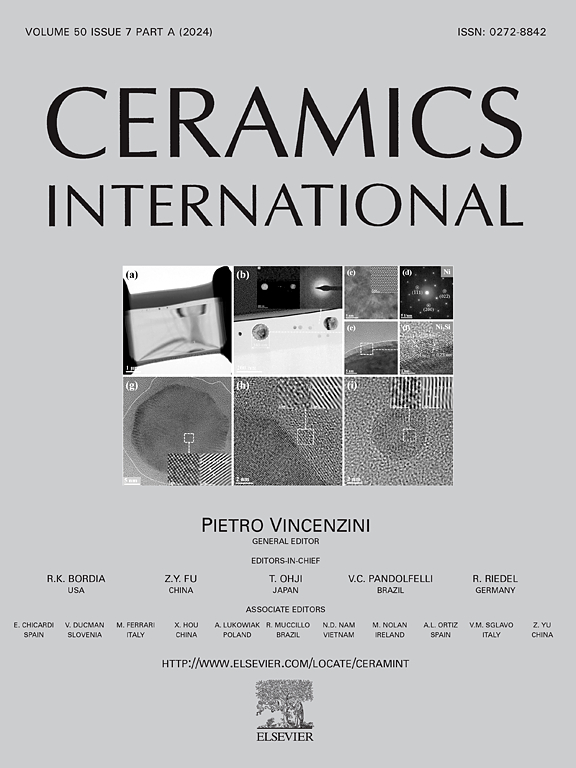Optimization of optical, dielectric and impedance properties of pyramid shaped strontium cerium oxide synthesized via solution combustion technique
IF 5.6
2区 材料科学
Q1 MATERIALS SCIENCE, CERAMICS
引用次数: 0
Abstract
In the present communication, we report the results of the investigations on the optical and electrical properties of strontium cerium oxide SrCeO3 (SCO), prepared by solution combustion method, in the contexts of structural integrity, crystallite size and compositional homogeneity. SCO possesses orthorhombic crystal structure having an average crystallite size of ∼14 nm and an average grain size ∼95 μm. Optical characterization reveals a wide band gap of ∼3.18 eV that makes SCO compound suitable for sensor application. Energy–dispersive X–ray (EDX) spectroscopy confirms the phase purity of SCO compound. Fourier transform infrared (FTIR) and Raman spectroscopies elucidate the characteristic chemical bonds and vibrational modes. Temperature dependent dielectric and impedance studies reveal the ionic diffusion and semiconducting nature of SCO compound. AC conductivity, recorded at different temperatures, has been understood based on the Jonscher's power law with the confirmation of correlated barrier hopping (CBH) as a responsible mechanism for charge conduction across the SCO lattice. The results establish SCO's capability to support high-performance devices requiring superior optical, structural, and dielectric stability. By leveraging its unique properties, SCO emerges as a material poised to drive advancements in next-generation technologies.
溶液燃烧法合成金字塔形氧化锶铈的光学、介电和阻抗性能优化
在本通讯中,我们报告了用溶液燃烧法制备的锶铈氧化物SrCeO3 (SCO)在结构完整性、晶粒尺寸和成分均匀性方面的光学和电学性质的研究结果。SCO具有正交晶型结构,平均晶粒尺寸为~ 14 nm,平均晶粒尺寸为~ 95 μm。光学特性揭示了约3.18 eV的宽带隙,使SCO化合物适合传感器应用。能量色散x射线(EDX)光谱证实了SCO化合物的相纯度。傅里叶变换红外光谱(FTIR)和拉曼光谱阐明了其特征化学键和振动模式。温度相关的介电和阻抗研究揭示了SCO化合物的离子扩散和半导体性质。根据Jonscher幂定律,在不同温度下记录的交流电导率已经被理解,并证实了相关势垒跳变(CBH)是SCO晶格上电荷传导的负责机制。结果建立SCO的能力,以支持高性能器件需要优越的光学,结构和介电稳定性。通过利用其独特的性能,SCO成为一种有望推动下一代技术进步的材料。
本文章由计算机程序翻译,如有差异,请以英文原文为准。
求助全文
约1分钟内获得全文
求助全文
来源期刊

Ceramics International
工程技术-材料科学:硅酸盐
CiteScore
9.40
自引率
15.40%
发文量
4558
审稿时长
25 days
期刊介绍:
Ceramics International covers the science of advanced ceramic materials. The journal encourages contributions that demonstrate how an understanding of the basic chemical and physical phenomena may direct materials design and stimulate ideas for new or improved processing techniques, in order to obtain materials with desired structural features and properties.
Ceramics International covers oxide and non-oxide ceramics, functional glasses, glass ceramics, amorphous inorganic non-metallic materials (and their combinations with metal and organic materials), in the form of particulates, dense or porous bodies, thin/thick films and laminated, graded and composite structures. Process related topics such as ceramic-ceramic joints or joining ceramics with dissimilar materials, as well as surface finishing and conditioning are also covered. Besides traditional processing techniques, manufacturing routes of interest include innovative procedures benefiting from externally applied stresses, electromagnetic fields and energetic beams, as well as top-down and self-assembly nanotechnology approaches. In addition, the journal welcomes submissions on bio-inspired and bio-enabled materials designs, experimentally validated multi scale modelling and simulation for materials design, and the use of the most advanced chemical and physical characterization techniques of structure, properties and behaviour.
Technologically relevant low-dimensional systems are a particular focus of Ceramics International. These include 0, 1 and 2-D nanomaterials (also covering CNTs, graphene and related materials, and diamond-like carbons), their nanocomposites, as well as nano-hybrids and hierarchical multifunctional nanostructures that might integrate molecular, biological and electronic components.
 求助内容:
求助内容: 应助结果提醒方式:
应助结果提醒方式:


